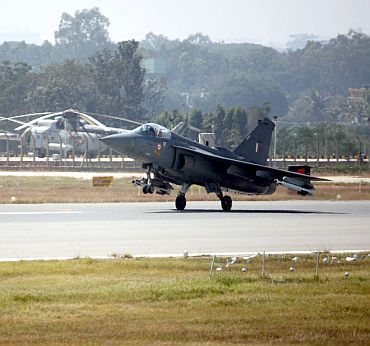 | « Back to article | Print this article |
 The Tejas has flown an unprecedented 450 test flights this year towards a splashy ceremony in Bangalore scheduled for December 20, where Defence Minister AK Antony will preside over its induction into the Indian Air Force, says Ajai Shukla.
The Tejas has flown an unprecedented 450 test flights this year towards a splashy ceremony in Bangalore scheduled for December 20, where Defence Minister AK Antony will preside over its induction into the Indian Air Force, says Ajai Shukla.
If the indigenous Tejas light combat aircraft has taken decades for completion, it is now in a record-breaking sprint to the finish line. The Tejas has flown an unprecedented 450 test flights this year towards a splashy ceremony in Bangalore scheduled for December 20, where Defence Minister AK Antony will preside over its induction into the Indian Air Force.
That landmark event will be the award of the Tejas's Initial Operational Certificate, which will allow the country's first indigenous modern fighter to be flown by regular pilots of the IAF. The first Tejas squadron (18-20 fighters) will be based at Sulur, near Coimbatore.
So far, only highly qualified test pilots of the National Flight Testing Centre in Bangalore have flown the Tejas. In the 2,400 test flights since it took to the air in 2001, the NFTC has incrementally flown the Tejas higher, faster and carried out increasingly difficult manoeuvres and weapon firings to test it meets the IAF's requirements.
On Saturday, Group Captain Suneet Krishna, a veteran NFTC test pilot, fired an air-to-air missile from the Tejas at an airborne target off the Goa coast, striking the target and taking the Tejas a step closer towards IOC.
While awarding the IOC, Antony will ceremonially hand over to the IAF boss, Air Chief Marshal N A K Browne, the fighter's ‘Release to Service Document‘, which specifies the capabilities the Tejas has already demonstrated during flight testing.
This includes aerodynamic capabilities like speed, acceleration, climb rate and angle of attack; and also the basic weapons operations already tested on the Tejas, and the fighter's proven radar and sensor capabilities. The Tejas flight-testing programme has been a prolonged and painstaking exercise, since this is India's first modern fighter. The Aeronautical Development Agency -- a special purpose vehicle of the Defence R&D Organisation, set up to manage the Tejas programme -- worried that a crash during flight-testing might be a fatal blow to the project itself, and so has handled flight testing cautiously, taking twice the time that experienced countries do.
Once the IOC is awarded, Hindustan Aeronautics Ltd will build the IAF's first 20 Tejas fighters on a brand new production line in Bangalore. HAL has told Business Standard that it aims to roll out the first two fighters by March 2014, deliver eight fighters by end-2014, and then enhance the production line's capability to 16 fighters a year.
So far, the IAF has committed to just 40 Tejas fighters. Of these, 20 will be built to IOC standards, and the next 20 ordered when Final Operation Clearance is obtained. The defence minister has ordered the DRDO to ensure the FOC is not delayed beyond end-2014.
Avinash Chander, the DRDO chief, tells Business Standard the FOC will involve firing a range of different weapons, including missiles and bombs, and testing the fighter for mid-air refuelling.
"With the IAF now enthused about the Tejas, and participating actively in the project, we will surely obtain FOC next year. We could not have completed over 450 test flights this year without close cooperation between the IAF, ADA and HAL," says Chander.
After obtaining an FOC for the Tejas, ADA will start work on the Tejas Mark II. The key change is replacing the General Electric F-404 engine that powers the Mark I with the larger, more powerful GE F-414 engine. This will involve re-engineering the Mark I to fit in the bulkier F-414, a technological challenge for ADA.
ADA has also briefed Business Standard that the Tejas Mark II would have more fuel capacity for added range; a retractable mid-air refuelling system; a DRDO-built Airborne Electronically Scanned Array radar; world beating air-to-air missiles; an on-board oxygen-generating system, and a state-of-the-art Electronic Warfare suite to confuse enemy radars and sensors. "Eventually, the IAF is very likely to have at least 200 Tejas fighters in its fleet," says Chander.